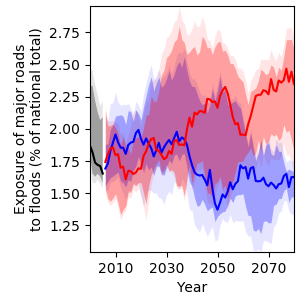Kenya: Infrastructure
Climate change is expected to significantly affect Kenya’s infrastructure sector through extreme weather events, such as floods and droughts. High precipitation amounts can lead to flooding of transport infrastructure, especially in coastal areas with low altitudes, while high temperatures can cause roads, bridges and protective structures to develop cracks and degrade more quickly. This will require earlier replacement and lead to higher maintenance and replacement costs. Transport infrastructure is vulnerable to extreme weather events, yet essential for agricultural livelihoods. Roads serve communities to trade goods and access healthcare, education, credit and other services. Especially in rural areas, Kenya’s transport sector is dominated by road transport, which accounts for 99 % of non-aviation transport GHG emissions [25]. Investments will have to be made into building climate-resilient road networks.
Extreme weather events will also have devastating effects on human settlements and economic production sites, especially in urban areas with high population densities such as Nairobi or Mombasa. Informal settlements are particularly vulnerable to extreme weather events: Makeshift homes are often built in unstable geographical locations including riverbanks and coastal areas, where flooding can lead to loss of housing, contamination of water, injury or death. Dwellers usually have low adaptive capacity to respond to such events due to high levels of poverty and lack of risk-reducing infrastructures. According to a study on urban flooding in Kibera, Nairobi’s largest informal settlement with a population of more than 300 000, over 50 % of residents reported that their houses were flooded in the 2015 rainy season [26]. The study documents various consequences including death, outbreaks of cholera and diarrhoea as well as the destruction of houses and other types of property.
Despite the risk of infrastructure damage being likely to increase due to climate change, precise predictions of the location and extent of exposure are difficult to make. For example, projections of river flood events are subject to substantial modelling uncertainty, largely due to the uncertainty of future projections of precipitation amounts and their spatial distribution, affecting flood occurrence (see also Figure 5). In Kenya, projections show a slight decrease in the exposure of major roads to river floods under RCP2.6 and an increase under RCP6.0. In the year 2000, 1.9 % of major roads were exposed to river floods at least once a year, while by 2080, this value is projected to change to 2.3 % under RCP6.0 (Figure 13). In a similar way, exposure of urban land area to river floods is projected to barely change under RCP2.6, whilst increasing from 0.11 % in 2000 to 0.13 % in 2080 under RCP6.0 (Figure 14).


The exposure of the GDP to heatwaves is projected to increase from around 0.7 % in 2000 to 5.7 % (RCP2.6) and 7.0 % (RCP6.0) by the end of the century (Figure 15). The very likely range of GDP exposure to heatwaves widens from 0.7–1.4 % in 2000 to 1.7–7.1 % (RCP2.6) and 6.7–11.1 % (RCP6.0) in 2080. Hence, it is recommended that economic policy makers start identifying heat-sensitive production sites and activities, and integrating climate adaptation strategies, such as improved solar-powered cooling systems, “cool roof” isolation materials or switching the operating hours from day to night [27].

References
[25] L. Cameron, L. Würtenberger, and S. Stiebert, “Kenya’s Climate Change Action Plan: Mitigation. Chapter 7: Transport,” Nairobi, Kenya, 2012.
[26] KDI – Kounkuey Design Initiative, “Building Urban Flood Resilience: Integrating Community Perspectives, Final Report 2015–2016,” Nairobi, Kenya, 2016.
[27] M. Dabaieh, O. Wanas, M. A. Hegazy, and E. Johansson, “Reducing Cooling Demands in a Hot Dry Climate: A Simulation Study for Non-Insulated Passive Cool Roof Thermal Performance in Residential Buildings,” Energy Build., vol. 89, pp. 142–152, 2015.


